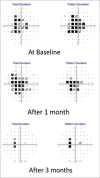Clinical profile, multimodal imaging, and treatment response in macular serpiginous choroiditis
- PMID: 35086211
- PMCID: PMC9023938
- DOI: 10.4103/ijo.IJO_2140_21
Clinical profile, multimodal imaging, and treatment response in macular serpiginous choroiditis
Abstract
Purpose: To describe the clinical profile, multimodal imaging, and treatment response in macular serpiginous choroiditis (MSC).
Methods: Clinical records of 16 eyes (14 patients) with MSC presenting to a tertiary eye care institute between 2015 and 2019 were analyzed retrospectively.
Results: Mean age of 14 patients presenting with MSC was 33 ± 13 yrs with 64% males and 36% females. Mean visual acuity of the eyes with MSC at presentation was 0.43 ± 0.46 (logMAR) improving to 0.16 ± 0.28 (logMAR) at final visit. Thirteen eyes (81.3%) had active lesion at presentation. Mantoux test was positive in seven patients (50%) and QuantiFERON TB gold test positive in 10 patients (71%). HRCT chest showed latent tuberculosis in seven patients (50%). All patients underwent multimodal imaging. All patients received oral steroids as treatment therapy; 11 patients also received immunosuppressives, nine patients received additional anti-tubercular therapy (ATT). Mean duration of follow-up for the patients was 18 ± 10 months. A total of eight (50%) eyes had recurrence of lesions after an average duration of 14 ± 14 (3-36) months and were restarted on the treatment as per the requirement. At final follow-up, all eyes showed a good response to treatment and had healed lesions. Comparing the final BCVA to the initial BCVA, 38% (n = 6) showed improvement, 56% (n = 9) remained stable, and 6% (n = 1) eyes worsened at the final follow-up.
Conclusion: Clinical profile and presentation of MSC is similar to that of CSC, and combination treatment with intravenous methyl prednisolone (IVMP), steroids, immunosuppressives, and ATT can salvage vision. A high suspicion of associated tuberculosis in endemic regions should be kept in mind.
Keywords: Fundus fluroroscein angiography; Indocyanin green angiography; macular serpiginous choroiditis; multimodal imaging; optical coherence tomography angiography; serpiginous choroiditis; tuberculosis.
Conflict of interest statement
None
Figures





Comment in
-
Commentary: Importance of ocular imaging in macular serpiginous choroiditis.Indian J Ophthalmol. 2022 Feb;70(2):441-442. doi: 10.4103/ijo.IJO_2697_21. Indian J Ophthalmol. 2022. PMID: 35086212 Free PMC article. No abstract available.
Similar articles
-
Tubercular serpiginous-like choroiditis presenting as multifocal serpiginoid choroiditis.Ophthalmology. 2012 Nov;119(11):2334-42. doi: 10.1016/j.ophtha.2012.05.034. Epub 2012 Aug 11. Ophthalmology. 2012. PMID: 22892153
-
LONGITUDINAL FOLLOW-UP OF TUBERCULAR SERPIGINOUS-LIKE CHOROIDITIS USING OPTICAL COHERENCE TOMOGRAPHY ANGIOGRAPHY.Retina. 2021 Apr 1;41(4):793-803. doi: 10.1097/IAE.0000000000002915. Retina. 2021. PMID: 32833411
-
Multimodal Imaging of Serpiginous Choroiditis.Optom Vis Sci. 2017 Feb;94(2):265-269. doi: 10.1097/OPX.0000000000001015. Optom Vis Sci. 2017. PMID: 27779556
-
Tuberculosis-related serpiginous choroiditis: aggressive therapy with dual concomitant combination of multiple anti-tubercular and multiple immunosuppressive agents is needed to halt the progression of the disease.J Ophthalmic Inflamm Infect. 2022 Feb 8;12(1):7. doi: 10.1186/s12348-022-00282-6. J Ophthalmic Inflamm Infect. 2022. PMID: 35132499 Free PMC article. Review.
-
Tubercular serpiginous choroiditis.J Ophthalmic Inflamm Infect. 2022 Nov 9;12(1):37. doi: 10.1186/s12348-022-00312-3. J Ophthalmic Inflamm Infect. 2022. PMID: 36352169 Free PMC article. Review.
Cited by
-
Commentary: Importance of ocular imaging in macular serpiginous choroiditis.Indian J Ophthalmol. 2022 Feb;70(2):441-442. doi: 10.4103/ijo.IJO_2697_21. Indian J Ophthalmol. 2022. PMID: 35086212 Free PMC article. No abstract available.
References
-
- Schatz H, Maumence AE, Patz A. Geographical helicoid peripapillary choroidopathy: Clinical presentation and fluorescein angiographic findings. Trans Am Acad Ophthalmol Otolaryngol. 1974;78:747–61.
-
- Weiss H, Annesley WH, Jr, Shields JA, Tomer T. The clinical course of serpiginous choroidopathy. Am J Ophthalmol. 1979;87:133–42. - PubMed
-
- Vasconcelos-Santos DV, Rao PK, Davies JB, Sohn EH, Rao NA. Clinical features of tuberculous serpiginouslike choroiditis in contrast to classic serpiginous choroiditis. Arch Ophthalmol. 2010;128:853–8. - PubMed
-
- Gupta V, Gupta A, Arora S, Bambery P, Dogra MR, Agarwal A, et al. Presumed tubercular serpiginouslike choroiditis: Clinical presentations and management. Ophthalmology. 2003;110:1744–9. - PubMed
MeSH terms
LinkOut - more resources
Full Text Sources

